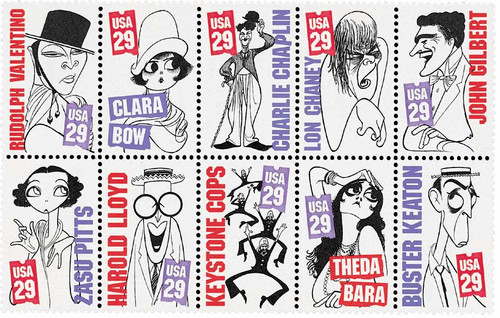
# 2819 FDC - 1994 29c Silent Screen Stars: Rudolph Valentino
U.S. #2819
1994 Rudolph Valentino
- Honors legendary stars of the Silent Film Era
- Designed by famed caricaturist Al Hirschfeld
Stamp Category: Commemorative
Set: Silent Screen Stars
Value: 29c
First Day of Issue: April 27, 1994
First Day City: San Francisco, California
Quantity Issued: 1,860,000
Printed By: Bureau of Engraving and Printing
Printing Method: Lithographed and engraved.
Format: Vertical stamps issued se-tenant with nine other silent film stars in four panes of 40 stamps
Perforations: 11.2
Why the stamp was issued: Issued as part of the Silent Screen Stars set of 10, honoring the great names of the early days of Hollywood movie making.
About the stamp design: The stamp was designed by renowned artist Al Hirschfeld. Art direction and typographer was Howard Paine. The artist’s caricature style was the same as his earlier work on the Comedians se-tenant booklet pane of five. The 29c denomination was printed in drop-out type on a stylized torn ticket stub.
First Day of Issue Ceremony: Castro Theater in San Francisco was the site of the First Day Ceremony with actor Karl Malden as the main speaker.
Unusual fact about this stamp: The artist was asked to work his daughter Nina’s name into his caricatures, as he had often done in previous drawings. In Valentino’s case, his Nina is found in the folds of his cape, finishing on his shoulder and upper arm.
About the set: Besides Rudolf Valentino, popularly known as “The Sheik”, the Silent Screen Stars set includes nine other prominent stars of the Silent Screen era: “It Girl” Clara Bow, “Little Tramp” Charlie Chaplin, “Man of a Thousand Faces” Lon Chaney, “The Vamp” Theda Bara plus John Gilbert, Zasu Pitts, Harold Lloyd, Keystone Cops, and Buster Keaton. Several of the images include the artist’s familiar “Nina”.
History behind the stamp: Rudolf Valentino was idolized as the “Great Lover” of the 1920s, Rudolph Valentino gained enormous fame for his passionate, romantic roles. Born Rodolfo d’Antonguollo in Castellaneta, Italy, he moved to New York City in 1913 where he worked briefly as a gardener, dishwasher, and vaudeville dancer before beginning his film career in 1918.
Although his performance in The Four Horsemen of the Apocalypse (1921) established Valentino as a star, it was his role as the desert warrior in The Sheik (1921), that gained him a national following – making him the most popular romantic star of the silent film era. Following his lead, men learned to tango and tantalize women with smoldering, sensuous stares. And college men, imitating their idol, slicked back their hair and called themselves “sheiks.”
Valentino went on to make several other films including Blood and Sand (1922), The Eagle (1925), and The Son of the Sheik (1926). His sudden death at age 31 from a ruptured ulcer ended his brilliant career.
U.S. #2819
1994 Rudolph Valentino
- Honors legendary stars of the Silent Film Era
- Designed by famed caricaturist Al Hirschfeld
Stamp Category: Commemorative
Set: Silent Screen Stars
Value: 29c
First Day of Issue: April 27, 1994
First Day City: San Francisco, California
Quantity Issued: 1,860,000
Printed By: Bureau of Engraving and Printing
Printing Method: Lithographed and engraved.
Format: Vertical stamps issued se-tenant with nine other silent film stars in four panes of 40 stamps
Perforations: 11.2
Why the stamp was issued: Issued as part of the Silent Screen Stars set of 10, honoring the great names of the early days of Hollywood movie making.
About the stamp design: The stamp was designed by renowned artist Al Hirschfeld. Art direction and typographer was Howard Paine. The artist’s caricature style was the same as his earlier work on the Comedians se-tenant booklet pane of five. The 29c denomination was printed in drop-out type on a stylized torn ticket stub.
First Day of Issue Ceremony: Castro Theater in San Francisco was the site of the First Day Ceremony with actor Karl Malden as the main speaker.
Unusual fact about this stamp: The artist was asked to work his daughter Nina’s name into his caricatures, as he had often done in previous drawings. In Valentino’s case, his Nina is found in the folds of his cape, finishing on his shoulder and upper arm.
About the set: Besides Rudolf Valentino, popularly known as “The Sheik”, the Silent Screen Stars set includes nine other prominent stars of the Silent Screen era: “It Girl” Clara Bow, “Little Tramp” Charlie Chaplin, “Man of a Thousand Faces” Lon Chaney, “The Vamp” Theda Bara plus John Gilbert, Zasu Pitts, Harold Lloyd, Keystone Cops, and Buster Keaton. Several of the images include the artist’s familiar “Nina”.
History behind the stamp: Rudolf Valentino was idolized as the “Great Lover” of the 1920s, Rudolph Valentino gained enormous fame for his passionate, romantic roles. Born Rodolfo d’Antonguollo in Castellaneta, Italy, he moved to New York City in 1913 where he worked briefly as a gardener, dishwasher, and vaudeville dancer before beginning his film career in 1918.
Although his performance in The Four Horsemen of the Apocalypse (1921) established Valentino as a star, it was his role as the desert warrior in The Sheik (1921), that gained him a national following – making him the most popular romantic star of the silent film era. Following his lead, men learned to tango and tantalize women with smoldering, sensuous stares. And college men, imitating their idol, slicked back their hair and called themselves “sheiks.”
Valentino went on to make several other films including Blood and Sand (1922), The Eagle (1925), and The Son of the Sheik (1926). His sudden death at age 31 from a ruptured ulcer ended his brilliant career.













